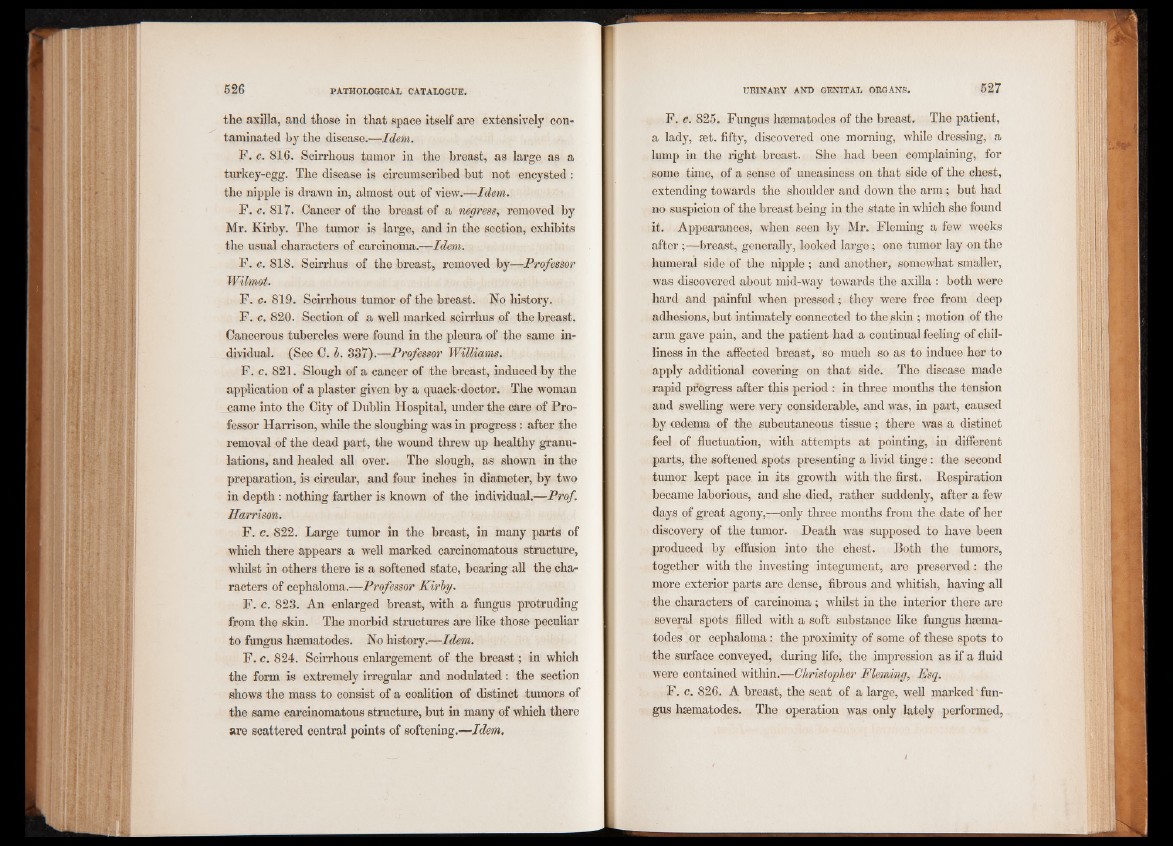
the axilla, and those in that space itself are extensively contaminated
by the disease.—Idem.
F. c. 816. Scirrhous tumor in the breast, as large as a
turkey-egg. The disease is circumscribed but not encysted :
the nipple is drawn in, almost out of view.—Idem.
F. c. 817. Cancer of the breast of a negress, removed by
Mr. Kirby. The tumor is large, and in the section, exhibits
the usual characters of carcinoma.—Idem.
F. c. 818. Scirrhus of the breast, removed by—Professor
Wilmot.
F. c. 819. Scirrhous tumor of the breast. No history.
F. c. 820. Section of a well marked scirrhus of the breast.
Cancerous tubercles were found in the pleura of the same individual.
(See C. b. 337).—Professor Williams.
F. c. 821. Slough of a cancer of the breast, induced by the
application of a plaster given by a quack-doctor. The woman
came into the City of Dublin Hospital, under the care of Professor
Harrison, while the sloughing was in progress : after the
removal of the dead part, the wound threw up healthy granulations,
and healed all over. The slough, as shown in the
preparation, is circular, and four inches in diameter, by two
in depth : nothing farther is known of the individual.—Prof.
Harrison.
F. c. 822. Large tumor in the breast, in many parts of
which there appears a well marked carcinomatous structure,
whilst in others there is a softened state, bearing all the characters
of cephaloma.—Professor Kirby.
F. c. 823. An enlarged breast, with a fungus protruding
from the skin. The morbid structures are like those peculiar
to fungus hsematodes. No history.—Idem.
F. c. 824. Scirrhous enlargement of the breast; in which
the form is extremely irregular and nodulated: the section
shows the mass to consist of a coalition of distinct tumors of
the same carcinomatous structure, but in many of which there
are scattered central points of softening.—Idem.
F. c. 825. Fungus hsematodes of the breast. The patient,
a lady, set. fifty, discovered one morning, while dressing, a
lump in the right breast. She had been complaining, for
some time, of a sense of uneasiness on that side of the chest,
extending towards the shoulder and down the arm; but had
no suspicion of the breast being in the state in which she found
it. Appearances, when seen by Mr. Fleming a few weeks
after;—breast, generally, looked large; one tumor lay on the
humeral side of the nipple ; and another, somewhat smaller,
was discovered about mid-way towards the axilla : both were
hard and painful when pressed; they were free from deep
adhesions, but intimately connected to the skin ; motion of the
arm gave pain, and the patient had a continual feeling of chilliness
in the affected breast, so much so as to induce her to
apply additional covering on that side. The disease made
rapid progress after this period : in three months the tension
and swelling were very considerable, and was, in part, caused
by oedema of the subcutaneous tissue; there was a distinct
feel of fluctuation, with attempts at pointing, in different
parts, the softened spots presenting a livid tinge: the seoond
tumor kept pace in its growth with the first. Respiration
became laborious, and she died, rather suddenly, after a few
days of great agony,—only three months from the date of her
discovery of the tumor. Death was supposed to have been
produced by effusion into the chest. Both the tumors,
together with the investing integument, are preserved: the
more exterior parts are dense, fibrous and whitish, having all
the characters of carcinoma; whilst in the interior there are
several spots filled with a soft substance like fungus hsematodes
, or cephaloma: the proximity of some of these spots to
the surface conveyed, during life, the impression as if a fluid
were contained within.—Christopher Fleming, Esq.
F. c. 826. A breast, the seat of a large, well marked fungus
hsematodes. The operation was only lately performed,